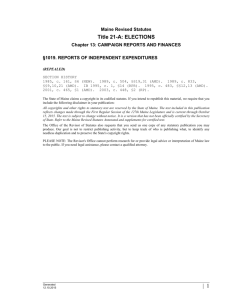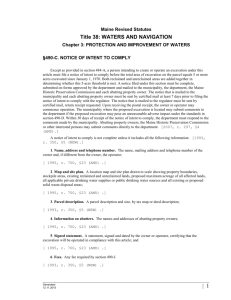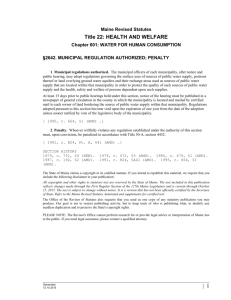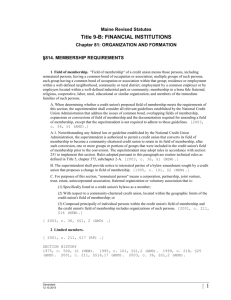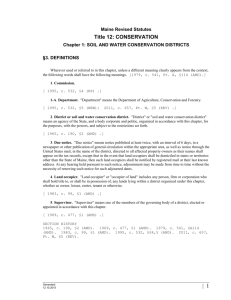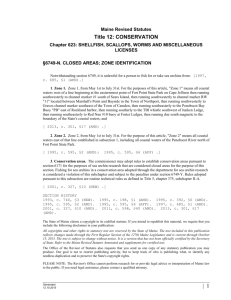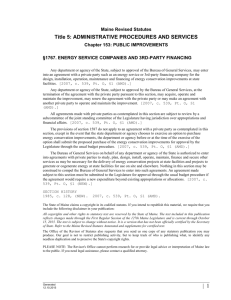Title 27: LIBRARIES, HISTORY, CULTURE AND
advertisement
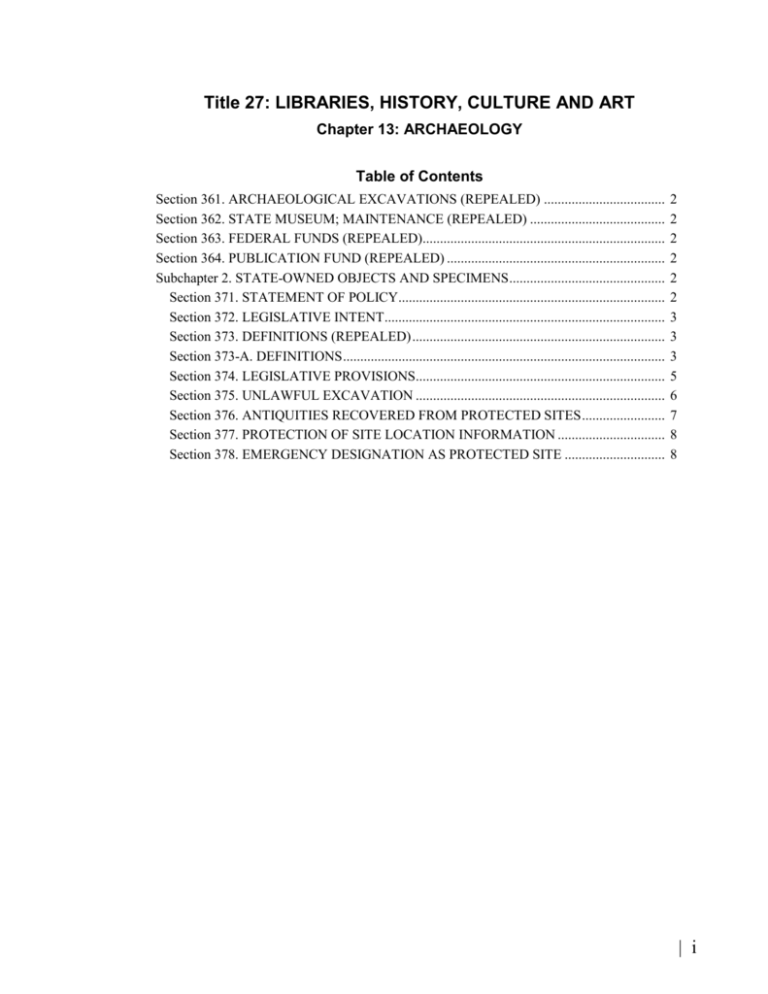
Title 27: LIBRARIES, HISTORY, CULTURE AND ART Chapter 13: ARCHAEOLOGY Table of Contents Section 361. ARCHAEOLOGICAL EXCAVATIONS (REPEALED) ................................... Section 362. STATE MUSEUM; MAINTENANCE (REPEALED) ....................................... Section 363. FEDERAL FUNDS (REPEALED)...................................................................... Section 364. PUBLICATION FUND (REPEALED) ............................................................... Subchapter 2. STATE-OWNED OBJECTS AND SPECIMENS ............................................. Section 371. STATEMENT OF POLICY............................................................................. Section 372. LEGISLATIVE INTENT................................................................................. Section 373. DEFINITIONS (REPEALED) ......................................................................... Section 373-A. DEFINITIONS ............................................................................................. Section 374. LEGISLATIVE PROVISIONS........................................................................ Section 375. UNLAWFUL EXCAVATION ........................................................................ Section 376. ANTIQUITIES RECOVERED FROM PROTECTED SITES ........................ Section 377. PROTECTION OF SITE LOCATION INFORMATION ............................... Section 378. EMERGENCY DESIGNATION AS PROTECTED SITE ............................. 2 2 2 2 2 2 3 3 3 5 6 7 8 8 | i Maine Revised Statutes Title 27: LIBRARIES, HISTORY, CULTURE AND ART Chapter 13: ARCHAEOLOGY §361. ARCHAEOLOGICAL EXCAVATIONS (REPEALED) SECTION HISTORY 1973, c. 460, §19 (AMD). 1981, c. 55, §1 (RP). §362. STATE MUSEUM; MAINTENANCE (REPEALED) SECTION HISTORY 1965, c. 502, §2 (RP). §363. FEDERAL FUNDS (REPEALED) SECTION HISTORY 1969, c. 407, (NEW). 1971, c. 544, §85 (RP). §364. PUBLICATION FUND (REPEALED) SECTION HISTORY 1969, c. 407, (NEW). 1971, c. 544, §85 (RP). Subchapter 2: STATE-OWNED OBJECTS AND SPECIMENS §371. STATEMENT OF POLICY The Legislature, in recognizing the importance of Maine's cultural heritage of the distant past to our understanding of Maine's people, declares that it is the policy of this State to preserve and protect archaeological sites for proper excavation and interpretation. [1981, c. 55, §2 (NEW).] It is in the public interest to provide for the preservation and interpretation of archaeological artifacts and specimens for the benefit of the people of the State. In order to ensure proper preservation and interpretation of artifacts, specimens and materials which are found on, in or beneath state-controlled lands, it is in the public interest that a single state department be designated to hold title, as trustee for the State, to all such artifacts, specimens and materials, except as may be authorized by section 376. [1981, c. 55, §2 (RPR).] The State Museum is best qualified to assume that trusteeship by virtue of the fact that its facilities are intended to function primarily for the purpose of preserving and interpreting artifacts, specimens and materials as defined within this subchapter. [1989, c. 700, Pt. A, §110 (AMD).] Generated 12.10.2015 | 2 MRS Title 27, Chapter 13: ARCHAEOLOGY SECTION HISTORY 1969, c. 398, (NEW). 1981, c. 55, §2 (RPR). 1989, c. 700, §A110 (AMD). §372. LEGISLATIVE INTENT 1. Transference of custody. The several departments of the State are authorized to transfer any archaeological objects, materials or specimens in their possession to the custody and trusteeship of the State Museum. [ 1989, c. 700, Pt. A, §111 (AMD) .] 2. Museum responsibility. The State designates the State Museum to hold title, as trustee for the State, to all archaeological objects, materials and specimens found on, in or beneath state-controlled lands. The State charges the State Museum with the responsibility of protecting, preserving and interpreting such objects, materials and specimens as may be placed under its trusteeship; preventing their defacement, damage, destruction or unauthorized removal; and ensuring their continued availability for scientific study by qualified persons, agencies or institutions. [ 1989, c. 700, Pt. A, §111 (AMD) .] 3. Consultation with federally recognized Indian tribes. In recognition of the interests of the federally recognized Indian tribes in this State in their archaeological heritage and in accordance with the requirements of federal law, including the National Historic Preservation Act of 1996, as amended, and the federal Native American Graves Protection and Repatriation Act, the Maine Historic Preservation Commission and the State Museum shall consult with federally recognized Indian tribes in this State concerning adequate and appropriate curation of archaeological materials excavated from protected sites. [ 2013, c. 89, §1 (NEW) .] SECTION HISTORY 1969, c. 398, (NEW). 1981, c. 55, §3 (RPR). 2013, c. 89, §1 (AMD). 1989, c. 700, §A111 (AMD). §373. DEFINITIONS (REPEALED) SECTION HISTORY 1969, c. 398, (NEW). 1981, c. 55, §4 (RP). §373-A. DEFINITIONS As used in this chapter, unless the context otherwise indicates, the following terms have the following meanings. [1981, c. 55, §5 (NEW).] 1. Artifact. "Artifact" means a physical entity which has been worked or modified by human action. [ 1981, c. 55, §5 (NEW) .] 2. Authorized representative. "Authorized representative" means any official or group of officials employed by the permittors or other competent person authorized in writing by the permittors. [ 1981, c. 55, §5 (NEW) .] Generated 12.10.2015 | 3 MRS Title 27, Chapter 13: ARCHAEOLOGY 3. Excavation. "Excavation" means any turning over, removal or disturbance of the soil, artifact in the soil or ground matrix or recovery or disturbance of artifacts that are fully or partially submerged in the water and tidal sites. "Excavation" includes, but is not limited to, activities such as purposeful looting, material procurement, construction activities or vandalism. In the case of private property the term "excavation" on a site does not include activities associated with agriculture or forestry unless specifically provided for in the permit or the preservation agreement as defined in Title 33, section 1551, subsection 2. [ 1995, c. 146, §1 (AMD) .] 3-A. Landowner. "Landowner" means any person, corporation, partnership, organization or other legal entity, including a municipality, county or other political subdivision of the State, an agency of the Federal Government and any quasi-governmental entity, which owns or controls a site. [ 1989, c. 171, §1 (NEW) .] 4. Materials. "Materials" means 3-dimensional items, other than artifacts and specimens, and excludes books, papers, manuscripts and archival or library material commonly included in the display or research collection of museums. [ 1981, c. 55, §5 (NEW) .] 5. Object. "Object" means any archaeological monument, artifact, relic or article. [ 1981, c. 55, §5 (NEW) .] 6. Permittors. "Permittors" means the Director of the Maine Historic Preservation Commission and the Director of the State Museum as well as the director of any state department administering state-controlled lands, acting in concert in the review, approval and granting of permits. [ 1989, c. 700, Pt. A, §112 (AMD) .] 7. Principal investigator. "Principal investigator" means the senior scientist in charge of an archaeological excavation. [ 1981, c. 55, §5 (NEW) .] 7-A. Protected site. "Protected site" means a site that is: A. On or under state-controlled land and is: (1) Listed in the National Register of Historic Places or judged eligible for national register listing by the Maine Historic Preservation Commission and, if the area is judged eligible for listing, the site designation is approved by the appropriate land managing agency director or local governing body; and (2) Posted; [2013, c. 89, §2 (NEW).] B. The subject of a preservation agreement between the landowner or landowners and the Maine Historic Preservation Commission pursuant to Title 33, section 1551 and is: (1) Listed in the National Register of Historic Places; and (2) Posted; or [2013, c. 89, §2 (NEW).] C. Subject to section 378. [2013, c. 89, §2 (NEW).] [ 2013, c. 89, §2 (NEW) .] 8. Site. "Site" means an area containing archaeological artifacts or materials or other evidence of habitation, occupation or other use by historic or prehistoric people. | 4 Generated 12.10.2015 MRS Title 27, Chapter 13: ARCHAEOLOGY A. [2013, c. 89, §3 (RP).] B. [2013, c. 89, §3 (RP).] C. [2013, c. 89, §3 (RP).] [ 2013, c. 89, §3 (AMD) .] 9. Specimen. "Specimen" means any items, set of items or parts of items collected as representative samples of geological media or biological forms found within the State. [ 1981, c. 55, §5 (NEW) .] 10. State-controlled land. "State-controlled land" means any land or water area owned in fee simple by the State, with the exception of those lands contained within Baxter State Park. State-controlled land includes, but is not limited to, state parks, state recreation areas, wilderness and wildlife preserves, located public lots and land beneath great ponds or navigable bodies of water and other submerged lands owned by the State. [ 1981, c. 55, §5 (NEW) .] SECTION HISTORY 1981, c. 55, §5 (NEW). 1981, c. 568, §§1-3 (AMD). 1989, c. 171, §1 (AMD). 1989, c. 700, §A112 (AMD). 1995, c. 146, §1 (AMD). 1999, c. 748, §1 (AMD). 2013, c. 89, §§2, 3 (AMD). §374. LEGISLATIVE PROVISIONS 1. Purpose. The people of this State benefit only when a protected site is systematically excavated, analyzed and interpreted by a qualified principal investigator. [ 2013, c. 89, §4 (AMD) .] 2. Permit procedure. The procedure for obtaining a permit to excavate a protected site is as follows. A. Any person, agency or institution desiring to excavate a protected site must submit a written application. [2013, c. 89, §4 (AMD).] B. Application for a permit must be in the form of a letter and research proposal directed to the Director of the Maine Historic Preservation Commission and be accompanied by a copy of the preservation agreement attested by the Register of Deeds and the written permission of the landowner to proceed with the excavation. The landowner may give permission to excavate in the preservation agreement. [2013, c. 89, §4 (AMD).] C. The permit to excavate must be cosigned by the Director of the Maine Historic Preservation Commission and the Director of the State Museum, except for state-controlled lands where the permit also must be cosigned by the director of the agency with primary jurisdiction. [2013, c. 89, §4 (AMD).] D. The application must state the nature and specific location of the artifacts, specimens and materials to be removed, the legal name and address of the person, agency or institution seeking authorization and the date or dates on which the artifacts, specimens or materials are to be removed. [2013, c. 89, §4 (AMD).] E. Upon receipt of an application, the permittors may issue a written permit authorizing the excavation of the protected site for such term and upon such conditions as they consider reasonable and that are consistent with subsection 3. [2013, c. 89, §4 (AMD).] [ 2013, c. 89, §4 (AMD) .] Generated 12.10.2015 | 5 MRS Title 27, Chapter 13: ARCHAEOLOGY 3. Permit conditions. The conditions that may be imposed upon a permit are as follows. A. In order to minimize damage to state-controlled lands and to artifacts, specimens or materials to be removed and in order to ensure the recording and preservation of significant data regarding those artifacts, specimens, materials or protected sites, the permit may set forth requirements or limitations regarding the methods and equipment to be employed in the removal, the procedures to be followed in documenting the removal and the report or reports, if any, to be submitted to officials or agencies of the State upon completion of the removal activities. [2013, c. 89, §4 (AMD).] B. The permittors may require that an authorized representative of the State be present to witness and document the removal of artifacts, specimens or materials from state-controlled land. [1981, c. 55, §6 (NEW).] C. The permit must clearly indicate the type of artifacts, specimens or materials to be removed, the location of the protected site, the time of the proposed removal activity or excavation, the legal name and address of the permittee and any other limitations and requirements that may be imposed by the permittors. [2013, c. 89, §4 (AMD).] D. On excavations authorized by the permit process, the principal investigator should normally possess the minimum qualifications of a graduate degree in anthropology, archaeology or a related field, accompanied by institutional facilities to ensure proper conservation and curation of the artifacts, materials and specimens or extensive experience and demonstrated ability. [1981, c. 55, §6 (NEW).] [ 2013, c. 89, §4 (AMD) .] 4. Permit revocation. All permittors, or their authorized representatives, may revoke or suspend a permit if there is evidence to indicate that the permittee has violated or exceeded the limitations of the permit, or if there is evidence to indicate that artifacts, materials or the protected site are being unnecessarily defaced, damaged or destroyed in the course of removal. Any willful violation of the provisions or limitations of a permit is grounds for immediate revocation of the permit and must be construed as unauthorized excavation. [ 2013, c. 89, §4 (AMD) .] 5. Permit possession. The permit must be retained in the personal possession of the permittee during the course of removal activities and must be made available for inspection upon demand of any authorized representative of the State. Any person or persons engaged in excavation on a protected site who do not produce a valid permit upon demand of an authorized representative of the State are presumptively engaged in unauthorized excavation. [ 2013, c. 89, §4 (AMD) .] SECTION HISTORY 1969, c. 398, (NEW). 1981, c. 55, §6 (RPR). 2013, c. 89, §4 (AMD). 1989, c. 700, §A113 (AMD). §375. UNLAWFUL EXCAVATION 1. Definition of unlawful excavation. "Unlawful excavation" means unauthorized excavation at a protected site, unless: A. A demonstrable emergency situation existed relating to the survival of the protected site; and [2013, c. 89, §5 (AMD).] B. An excavation permit is immediately applied for in accordance with section 374. [1981, c. 55, §7 (NEW).] [ 2013, c. 89, §5 (AMD) .] | 6 Generated 12.10.2015 MRS Title 27, Chapter 13: ARCHAEOLOGY 2. Penalty. Notwithstanding Title 17-A, sections 4-A and 1301, a violation of this chapter is a Class E crime for which a fine of not less than $250 must be adjudged. The unlawful excavation for any one day constitutes a separate violation. The court also may order the defendant to pay an amount equal to the reasonable cost of a proper archaeological excavation had the area that was unlawfully excavated been properly excavated. The Director of the Maine Historic Preservation Commission, in the name of the people of this State through the Attorney General, may in addition to other remedies provided bring an action for an injunction seeking one or more of the following remedies: A. To restrain a violation of this chapter; or [1999, c. 748, §2 (AMD).] B. To enjoin future unlawful excavation. [1999, c. 748, §2 (AMD).] C. [1999, c. 748, §2 (RP).] [ 1999, c. 748, §2 (AMD) .] 3. Prosecution. The Attorney General, upon receiving notification of a violation of this section from the Director of the Maine Historic Preservation Commission, is authorized to file a complaint against the person named in the District Court or the Superior Court of the district or county in which the person resides, or in the district or county in which the violation occurred. [ 1989, c. 171, §2 (AMD) .] SECTION HISTORY 1981, c. 55, §7 (NEW). 2013, c. 89, §5 (AMD). 1989, c. 171, §2 (AMD). 1999, c. 748, §2 (AMD). §376. ANTIQUITIES RECOVERED FROM PROTECTED SITES 1. State-owned artifacts to remain in Maine. No artifacts, objects, specimens or materials originating from a protected site on state-controlled land may be authorized to leave the State permanently without written permission of the permittors. They may be loaned for a term specified by the permittors for proper study or exhibit. [ 2013, c. 89, §6 (AMD) .] 2. Sale of artifacts. Attempts to sell, offers of sale and sale of artifacts, objects or specimens, excavated after the effective date of this Act, whether excavated lawfully or unlawfully from a protected site, without the written permission of the permit grantors or the Director of the Maine Historic Preservation Commission and the Director of the State Museum, are punishable by a civil penalty not greater than twice the price for which artifacts, objects or specimens are sold or offered for sale. [ 2013, c. 89, §6 (AMD) .] 3. Prosecution. The Attorney General, upon receiving notification and evidence of violation of this section from the Director of the Maine Historic Preservation Commission, is authorized to file a complaint against the person named in the District Court of the district in which the person resides or in the district in which the violation occurred. [ 2013, c. 89, §6 (AMD) .] 4. Artifact ownership. Artifacts, objects, materials and specimens recovered from protected sites on state-controlled land are the property of the State Museum. Artifacts, objects, specimens or materials originating from a site on other than state-controlled land are the property of the landowner and must be deposited with a suitable repository as designated by the landowner in the preservation agreement or the permit. Generated 12.10.2015 | 7 MRS Title 27, Chapter 13: ARCHAEOLOGY [ 2013, c. 89, §6 (AMD) .] SECTION HISTORY 1981, c. 55, §7 (NEW). (AMD). 1989, c. 700, §A114 (AMD). 2013, c. 89, §6 §377. PROTECTION OF SITE LOCATION INFORMATION In order to protect the site or protected site from unlawful excavation or harm, any information in the possession of the Maine Historic Preservation Commission, the State Museum, the Bureau of Parks and Lands, other state agencies or the University of Maine System about the location or other attributes of any site or protected site may be designated by the Maine Historic Preservation Commission or State Museum as confidential and exempt from Title 1, chapter 13. Such data must be made available for the purpose of archaeological research. The directors of the Maine Historic Preservation Commission and the State Museum shall jointly adopt rules establishing standards and procedures for obtaining the data, and may impose reasonable requirements on its use, including requirements of confidentiality. The directors of the Maine Historic Preservation Commission and the State Museum shall establish procedures for reviewing no less frequently than once every 10 years information designated as confidential under this section in order to determine whether continued confidentiality is necessary and, if not, to remove the confidentiality designation. [2013, c. 89, §7 (AMD); 2013, c. 405, Pt. A, §24 (REV).] SECTION HISTORY 1981, c. 55, §7 (NEW). 1985, c. 779, §74 (AMD). 1989, c. 700, §A115 (AMD). 1995, c. 502, §E30 (AMD). 2011, c. 657, Pt. W, §7 (REV). 2013, c. 89, §7 (AMD). 2013, c. 405, Pt. A, §24 (REV). §378. EMERGENCY DESIGNATION AS PROTECTED SITE In the case of an area containing archaeological materials or artifacts that is directly threatened with unauthorized excavation, the Director of the Maine Historic Preservation Commission, with the written permission of the landowner, may designate the area as a protected site that is subject to this chapter for a period not to exceed 10 years. The director and the landowner shall specify in writing the area that is subject to this chapter. All sites given emergency designation under this section must be posted against unauthorized excavation. [2013, c. 89, §8 (AMD).] SECTION HISTORY 1981, c. 568, §4 (NEW). 2013, c. 89, §8 (AMD). 1995, c. 146, §2 (AMD). 1999, c. 748, §3 (AMD). The State of Maine claims a copyright in its codified statutes. If you intend to republish this material, we require that you include the following disclaimer in your publication: All copyrights and other rights to statutory text are reserved by the State of Maine. The text included in this publication reflects changes made through the First Regular Session of the 127th Maine Legislature and is current through October 15, 2015. The text is subject to change without notice. It is a version that has not been officially certified by the Secretary of State. Refer to the Maine Revised Statutes Annotated and supplements for certified text. The Office of the Revisor of Statutes also requests that you send us one copy of any statutory publication you may produce. Our goal is not to restrict publishing activity, but to keep track of who is publishing what, to identify any needless duplication and to preserve the State's copyright rights. PLEASE NOTE: The Revisor's Office cannot perform research for or provide legal advice or interpretation of Maine law to the public. If you need legal assistance, please contact a qualified attorney. | 8 Generated 12.10.2015
